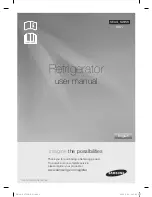
6
HANDLING & INSTALLATION
CONDENSATE PAN
INSTALLATION INSTRUCTIONS
MAKE SURE THE CABINET IS DISCONNECTED
FROM ITS POWER SOURCE
1. Remove and discard protective cover over electrical
receptacle on bottom of cabinet
2. Bend down front part of housing. (See above.)
3. Insert condensate evaporator pan assembly into the slide
supports on the underside of the cabinet by pushing
toward back of cabinet until it stops.
4. Plug supply cord into receptacle in underside of cabinet.
5. Bend up front part of housing. Line up slot with rivnut in
cabinet bottom and insert thumbscrew through slot onto
rivnut in cabinet bottom. Insert thumb screw through slot
onto rivnut and tighten.
6. The assembly will now operate when power is supplied to
the cabinet.
7. Inspect rear of cabinet to ensure that the drain line from
the evaporator is properly positioned over the conden-
sate pan.
On top mount models, allow a minimum of twelve (12) inch-
es between the top of the cabinet and ceiling and two (2)
inches from the back of the cabinet to the wall.
(Models with Bottom Mounted Compressor)
Remove the crate base mounting clips located behind the
front grill. Slide the cabinet forward on the crate base to clear
the rear mounting clips.
After removing the crate base, move the cabinet into loca-
tion. Make sure the cabinet is level to ensure operation of the
“self-closing” doors.
Allow a minimum of two (2) inches between the back of the
cabinet and the wall for proper air circulation through the
condensing unit.
CABINET STARTUP
Once the cabinet has been located in its permanent location
and the proper power and grounding have been provided,
the following items must be checked or completed:
1. Cut and remove the compressor hold-down band (if
applicable) so the compressor “floats” freely.
2. Check for traces of oil on the compressor pan which could
mean a broken or leaking refrigeration line.
2.
UNDER NO CIRCUMSTANCE SHOULD THE COM-
PRESSOR BE STARTED WHEN OIL IS PRESENT
UNTIL INSPECTED BY A SERVICE TECHNICIAN.
3. INSPECT THE FACTORY WIRING FOR TERMINALS
THAT MIGHT HAVE VIBRATED LOOSE IN SHIPPING.
TIGHTEN ALL SCREW-TYPE TERMINALS.
4. Check the refrigeration lines to see that they are “free”
and no damage was done during shipping.
5. Check fan blade(s) for “free” operation.
6. Turn on the main power switch. Once the compressor
starts, the voltage should be checked at the compressor
terminals to determine if there is proper voltage to the
compressor. The voltage should not exceed 10% above or
below the rated compressor voltage.
EXAMPLE: If the voltage reads 115 volts with no load and it
drops below 103 volts when the compressor starts, it
may indicate that the supply wiring is too small or that
the wire run is too long.
7. Make sure that the drain line has not been dislodged or
broken during shipping and that the drain trap termi-
nates properly in the condensate pan or floor drain.
(See Condensate Pan on top mounted compressor.)
8. Listen for any unusual noise such as lines vibrating, etc.
Correct problem by tightening screws, slightly bending
tubing, etc.
9. Check proper tension on doors. (See Door Torque
Adjustment.)
10. Cabinet should not be loaded with product until cabinet
has operated for 24 hours and reached desirable stor-
age temperature.
THERMOSTAT SETTINGS
The refrigerator is shipped from the factory with a thermostat
setting of approximately the mid-point of the operating
range. Final thermostat setting must be made in the field.
Allow the cabinet to operate until the compressor cycles on
the thermostat. The normal operating temperature range for
the refrigerator is:
32°F to 55°F (0°C to 13°C)
NOTE: DO NOT OPERATE THE CABINET WITH THERMO-
STAT SETTINGS BELOW 32°F (0°C).
The thermostat is easily adjusted with a standard screwdriv-
er. The thermostat has settings 1 through 7, turn the ther-
mostat to a higher number to lower the cabinet temperature.
The thermostat is located behind the evaporator front grill
and can be adjusted through the grill. On some models the
thermostat is located in the electrical box at the top of the
cabinet.
SCIENTIFIC CONTROL AND
ANNUNCIATOR PANELS
Cabinets for Scientific use may be equipped with a variety of
optional control, alarm, and recorder devices. Each cabinet
is shipped with the appropriate operators manual for the
device installed on the cabinet. These operator manuals per-
tain to the set-up and basic operation of the control panel
devices. For more comprehensive operation, repair, and
maintenance information refer to the control panel service
manual part number 51-0170-01.
FIGURE 2
Summary of Contents for BT30RF- EXPR
Page 15: ...SECTION II...
Page 26: ...ELECTRICAL BOX WIRING DIAGRAM 00 0056 00 WIRING DIAGRAM 25...
Page 27: ...ELECTRICAL BOX WIRING DIAGRAM 00 0057 00 26 WIRING DIAGRAM...
Page 28: ...ELECTRICAL BOX WIRING DIAGRAM 00 0064 00 WIRING DIAGRAM 27...
Page 49: ...INSTRUCTIONS SOLID DOOR REMOVAL INSTALLATION ADJUSTMENT 48 MAINTENANCE REPAIR...
Page 63: ...CASTER INSTALLATION INSTRUCTIONS 62 MAINTENANCE REPAIR...
Page 69: ...ELECTRICAL REFRIGERATION INFORMATION BT30RF EXPR Explosion Proof Refrigerator Freezer...
Page 79: ...ELECTRICAL REFRIGERATION INFORMATION ST260RI ST260RIR...
Page 81: ...MODULE 1 ANALOGIC PARAMETERS MODULE 1 PARAMETERS 83...
Page 83: ...MODULE 1 DAYTRONICS PARAMETERS MODULE 1 PARAMETERS 85...
Page 102: ...EVAPORATOR FAN SHROUD ASSEMBLY 104 EVAPORATOR FAN SHROUD ILLUSTRATION...
Page 105: ...EVAPORATOR FAN AREA BT30RSFMS BT50RSFMS EVAPORATOR FAN AREA ILLUSTRATION 107...









































